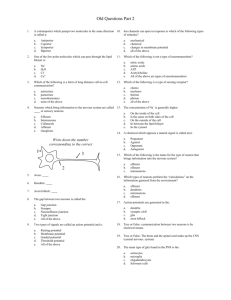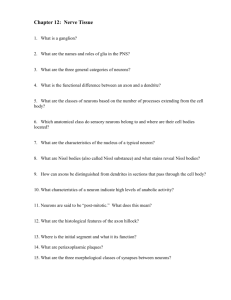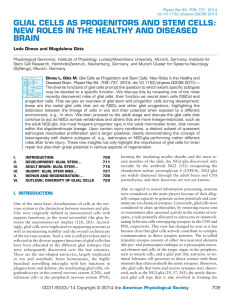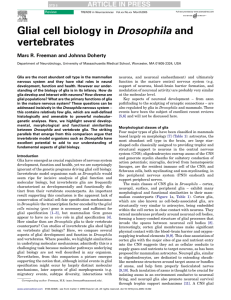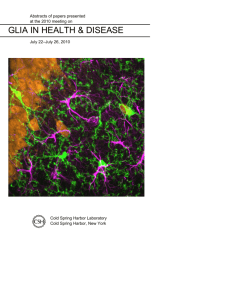CELLS of the NERVOUS SYSTEM I. NEURONS SOMA (CELL
advertisement
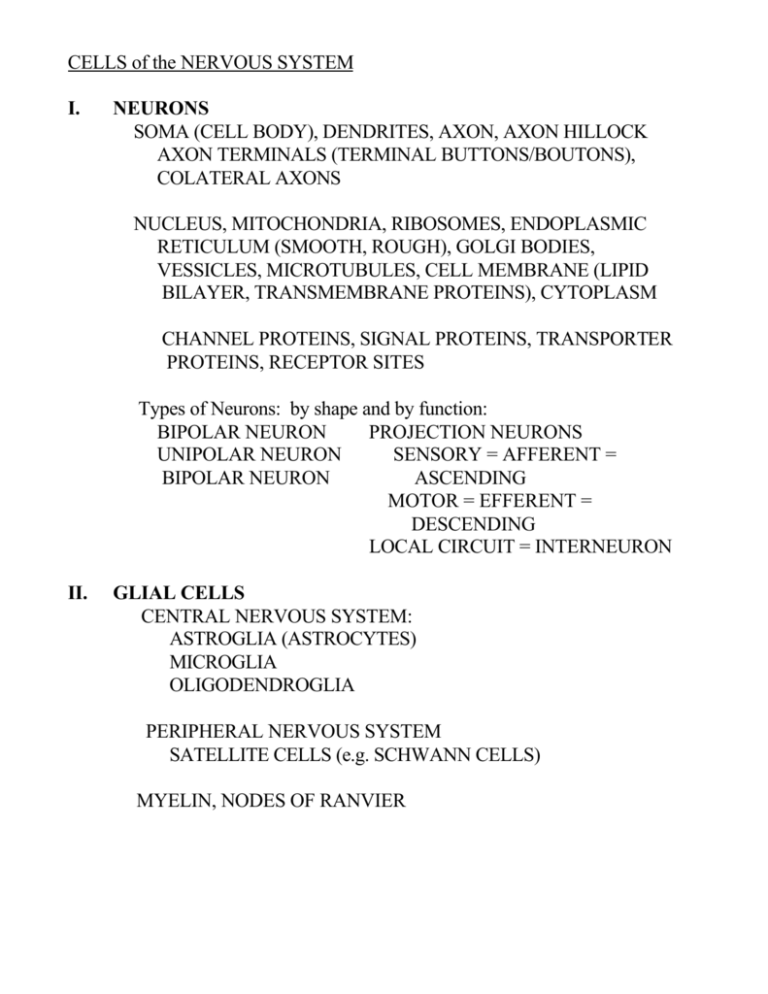
CELLS of the NERVOUS SYSTEM I. NEURONS SOMA (CELL BODY), DENDRITES, AXON, AXON HILLOCK AXON TERMINALS (TERMINAL BUTTONS/BOUTONS), COLATERAL AXONS NUCLEUS, MITOCHONDRIA, RIBOSOMES, ENDOPLASMIC RETICULUM (SMOOTH, ROUGH), GOLGI BODIES, VESSICLES, MICROTUBULES, CELL MEMBRANE (LIPID BILAYER, TRANSMEMBRANE PROTEINS), CYTOPLASM CHANNEL PROTEINS, SIGNAL PROTEINS, TRANSPORTER PROTEINS, RECEPTOR SITES Types of Neurons: by shape and by function: BIPOLAR NEURON PROJECTION NEURONS UNIPOLAR NEURON SENSORY = AFFERENT = BIPOLAR NEURON ASCENDING MOTOR = EFFERENT = DESCENDING LOCAL CIRCUIT = INTERNEURON II. GLIAL CELLS CENTRAL NERVOUS SYSTEM: ASTROGLIA (ASTROCYTES) MICROGLIA OLIGODENDROGLIA PERIPHERAL NERVOUS SYSTEM SATELLITE CELLS (e.g. SCHWANN CELLS) MYELIN, NODES OF RANVIER Terminology: CNS NUCLEI = TRACTS = GLIAL CELL= PNS GANGLIA NERVES SATELLITE CELL MULTIPLE SCLEROSIS AUTOIMMUNE DISORDER PREDNISONE EPENDYMAL CELLS CILIA, VENTRICLES, CEREBROSPINAL FLUID (CSF), CHOROID PLEXUS HYDROCEPHALY SHUNTS, CEREBRAL AQUEDUCT (between 3 & 4 ventricles) BLOOD-BRAIN BARRIER ASTROGLIA, ENDOTHELIAL CELLS (WALLS OF BLOOD VESSEL) AREA POSTREMA (in MEDULLA) New information on GLIA: glia outnumber neurons 10:l, meaning that 90% of brain is glia and 10% neurons l. glia perform many of the same functions as neurons a. produce and deliver brain chemicals that regulate neurons (and therefore, regulate behavior, learning, etc.) b. take up, store brain chemicals (e.g. glutamate) c. can release glutamate too (and other NTs) at a synapse, and change activity of post-synaptic neurons d. can soak up and release calcium, which also affects neuronal electrical activity e. maybe produce some sort of electrical/chemical signals (to influence neurons) 2. neurons cannot function without glial cells a. regulating the chemicals that surround neurons b. neurons do not conduct electrical signals (down axon) without astroglial cells being present…the signals is 100x slower than would be expected (lack of glutamate?) 3. have taken glial stem cells and turned them into neurons 4. without glial cells around, neurons take hours to die when starved of blood flow and O2; when glial cells are present with neurons, neurons die within minutes when anoxic….why? probably because glial cells are releasing glutamate --- causing neurons to fire more---neurons using up even more O2 --- neurons die faster (cause of the so-called One possible treatment for post-stroke victims would be to inhibit glial activity and reduce their release of glutamate 5. glial cells are less numerous in brains of persons with depression vs. NCs 6. glial cells may play a role in migraine headaches and in Alzheimers disease 7. astrocytes help build a wall around an area of damaged brain…which keeps out other cells that might help rebuild the area, repair the area; these astrocytes form a “scartissue” wall (e.g. in spinal cord injury) that hinder neural activity (sometimes called “reactive astroglia”)…why? A problem 8. And yet glial cells (probably astroglia) produce neurotropic growth factors that increase neural repair and regrowth… 9. oligodendroglia (surrounding axon, myelin sheath) help insulate axon are destroyed in persons with MS, by the person’s own immune system (form antibodies to the myelin protein)…why? 10. Microglia are the immune system cells in the brain These cells actually migrate into the brain from bone marrow Phagocytic – engulf the “garbage” left behind when cells are damaged or die But microglia can make that can make “free radical scavenger” cells that kill neurons .These FRS microglia and the scar tissue forming astroglia are found in the brains of Alzheimer’s patients, evidence of an inflammatory immune response. Is this a cause of or side-effect of the cause of Alzheimer’s disease? 11. tumors arising from glial cells are the most difficult to treat astrocytes are linked together by wide channels called “gap junctions”, that are so wide that even large molecules can travel through them easily/quickly cancerous glioma cells can also travel very easily thru these wide gap junction channels, diffuse deeply into brain tissue, via these astrocyte pathways e.g. malignant glioblastoma (rare but deadly, spreads thru out brain, cannot treat easily)

